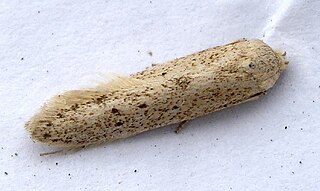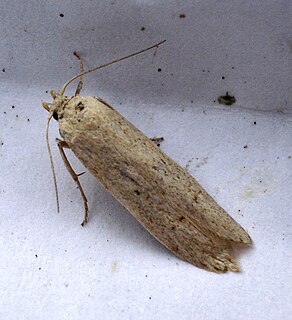
WWT Martin Mere is a wetland nature reserve and wildfowl collection managed by the Wildfowl and Wetlands Trust at Tarlscough, Burscough, Lancashire, England, on the West Lancashire Coastal Plain, 6 miles (10 km) from Ormskirk and 10 miles (16 km) from Southport (Merseyside). It is one of ten reserves managed by the charity, and it is designated an SSSI, an SPA and a Ramsar Site.

The Blastobasidae are a family of moths in the superfamily Gelechioidea. Its species can be found almost anywhere in the world, though in some places they are not native but introduced by humans. In some arrangements, these moths are included in the case-bearer family (Coleophoridae) as subfamily Blastobasinae. The Symmocidae are sometimes included in the Blastobasidae as subfamily or tribe.
Monochroa is a genus of moths in the family Gelechiidae.

Blastobasis is the type genus of the gelechioid moth family Blastobasidae; in some arrangements these are placed in the case-bearer family (Coleophoridae) as a subfamily. Within the Blastobasidae, the subfamily Blastobasinae has been established to distinguish the Blastobasis lineage from the group around Holcocera, but the delimitation is not yet well-resolved.

Blastobasis adustella is a species of moth of the family Blastobasidae. It is endemic to Australian region, but was introduced in western Europe and is now reported from The Netherlands, Great Britain, Ireland, Madeira and the Azores

Blastobasis lacticolella is a species of moth of the family Blastobasidae. It was introduced in western Europe and is now reported from the Netherlands, Great Britain and Madeira.
Vulcaniella extremella is a moth of the family Cosmopterigidae. It is found from Poland to the Iberian Peninsula, Italy, and Bulgaria and from France to central and southern Russia.
Blastobasis vittata is a moth of the family Blastobasidae. It was thought to be endemic to Madeira but is now known to inhabit the Netherlands, France, the Channel Islands, England and Northern Ireland.
Calycobathra variapenella is a moth in the family Cosmopterigidae. It is found in Turkey, the northern Caucasus, Transcaucasia and Central Asia.
Chrysoclista abchasica is a species of moth of the family Agonoxenidae. It is found in the Czech Republic, Georgia and Abkhazia (Transcaucasia).
Pyroderces apicinotella is a moth in the family Cosmopterigidae. It is found in Tunisia, Libya and Iraq.
Anatrachyntis coridophaga is a moth in the family Cosmopterigidae. It is found in Egypt and Libya.
Hodgesiella christophi is a moth of the family Cosmopterigidae that is endemic to Asia Minor.
Sorhagenia fibigeri is a moth in the family Cosmopterigidae. It is found in Asia Minor.
Ascalenia jerichoella is a moth in the family Cosmopterigidae. It is found in Israel.
Ascalenia bifasciella is a moth in the family Cosmopterigidae. It is found in North Africa.
Blastobasis maroccanella is a moth in the family Blastobasidae. It is found on the Azores, Madeira and in Portugal, Spain and Morocco. It was recently reported from California in the United States.
Scrobipalpa mixta is a moth in the family Gelechiidae. It was described by Peter Huemer and Ole Karsholt in 2010. It is found in North Macedonia, Albania and Ukraine.




